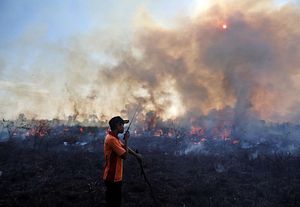As children and teenagers from over 100 countries went on strike and protested about the world’s inability to deal with climate change, the annual haze which suffocates much of Southeast Asia has made an unwanted return.
Southeasterly winds have pushed the noxious haze from Borneo and Sumatra in Indonesia as far as the Gulf of Thailand and into Vietnam and Cambodia. Authorities insist they are acting this year and have arrested over 200 people on suspicion of starting some of the fires to clear land for crops.
Indonesia’s environmental protection law carries a maximum 10-year prison sentence for setting fires to clear land, and its timber and plantation industries have again been accused of putting profit over the health of its own people in failing to prevent the wildfires. More than 200 companies and individual farmers have been named as responsible for starting the fires amid an unusually prolonged dry spell.
But this is still not enough.
Two months ago, Indonesia’s Supreme Court upheld a lower court ruling which found the administration of President Joko “Jokowi” Widodo were among those liable for the forest fires resulting in the 2015 regional haze.
Scientists have complained that Jokowi has not followed through with promised reforms, and last week the president admitted that negligence was part of the problem.
Fires were also lit in the Tesso Nilo National Park, home to about 140 endangered wild elephants, and cut across large swathes of land in southeast Borneo.
The haze stands as a key illustration of the difficulty of ASEAN countries tackling crucial issues together, all the more so as children across the Indo-Pacific region went on strike from school ahead of next week’s United Nations Climate Action Summit.
One study by Verdinand Robertua from the Christian University of Indonesia and a researcher at Marthinus Academy found annual forest fires contribute 60 percent of Indonesia’s total greenhouse gas emissions. Indonesia is the word’s third biggest emitter after China and the United States.
As with previous years, flights have been cancelled and people told to stay indoors where they are ordering food online. There has been a sharp increase in asthma attacks and Indonesia has opened temporary clinics and “oxygen houses” to treat people suffering from acute respiratory illness.
Air quality in Kuching, Malaysia, struck a level deemed “very unhealthy,” while Jakarta and Kuala Lumpur air quality was at an unhealthy level.
No financial estimates have been made for the current crisis. But the worst years included those such as 1997 and then in 2015, when fires cut across 2.6 million hectares and cost Indonesia $15.7 billion which was twice the costs of reconstruction following the deadly 2004 tsunami.
The transboundary haze was first recorded in 1972.
Malaysia is also handing out free N95 masks and launched an education program on the need to wear proper masks. It has also capped the price of N95 masks at about $24 a box or $1.44 for an individual mask.
This is not the first time the authorities have attempted to hold companies to account for the haze. Each year the same excuses are trotted out while the acrid smoke pollutes, damages health and makes life difficult for hundreds of million people.
The answers to mitigating this have long been straightforward, and the issue has been actually getting to implementation. It has long been clear that plantation owners and those responsible for the haze must be held accountable for criminal intent and the financial damage they have caused for decades, and that Southeast Asian countries need to make this a top priority. The haze is an annual reminder of how far the region has to go in confronting this central issue even as there are more global calls for the bigger objective of managing climate change.
Luke Hunt can be followed on Twitter @lukeanthonyhunt

































